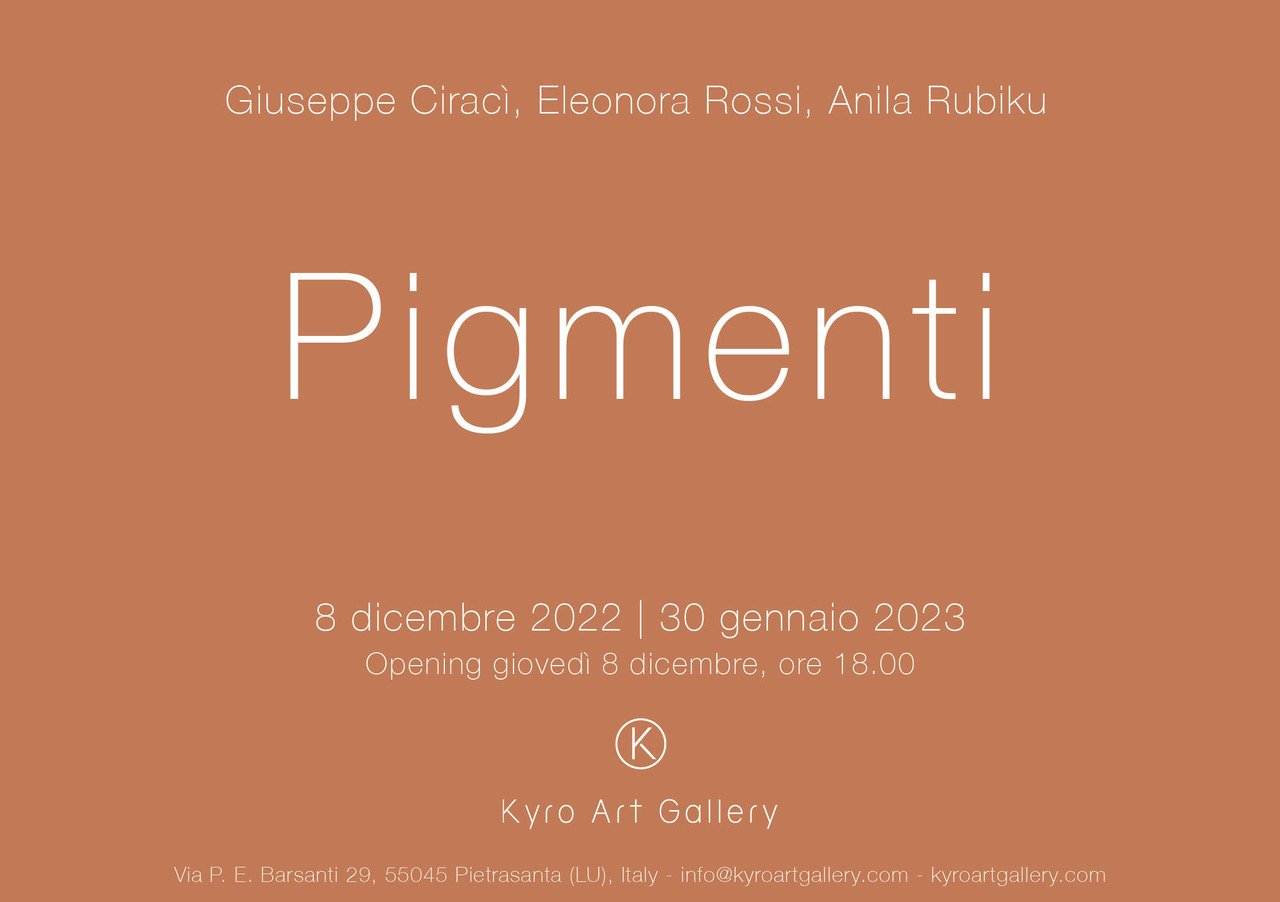
Collective Exhibition – Thursday 8 December 2022 – 30 January 2023
Vernissage: 8 December at 6 pm to 9 pm
Thursday 8 December at 6 pm in Pietrasanta (Lu) the Kyro Art Gallery concludes 2022 with the collective exhibition “Pigmenti”.
The exhibition juxtaposes the works of Giuseppe Ciracì, Eleonora Rossi and Anila Rubiku, highlighting the similarities of conception and specific expressive qualities. If painting means representing or transfiguring reality using colour as a tool, then it is pigment, that particular substance capable of changing the hue of a material, that is at the base of it all. The main characteristic of pigments, as opposed to dyes, is that they are insoluble in water and common solvents; they bond not chemically but physically. And it is precisely in reference to this concept of a physical bond that each artist, in the large, canvas-like white spaces of the gallery in Pietrasanta, starts with a single element and composes an installation in which the particular dialogues with the universal, creating visions and fixing images, shapes and colours. Pigments, in other words.
Time is the key that opens the door to Giuseppe Ciracì’s paintings. For several years now, he has been engaged in obsessive research into light, colour and nature, with an original, highly contemporary language that at the same time leads one to reflect on the inevitability of life slipping by and the fragility of human nature. Ciracì moves within the confines of history, art history in particular, reusing degraded pages torn from old manuals with their historic masterpieces in completely altered colours, which in turn are voluntarily exposed to the ravages of the elements. It is only several weeks later that the pages – blemished and chromatically transformed by nature – are ready for the artist’s work, who uses them as a starting point for his paintings. Blue becomes the colour defined by time on these pages; an ancient pigment, precious and rare in nature, and the dominant motif of the works that attempt to reconcile the past with the present while searching for further tools to read and investigate the future.
Eleonora Rossi presents “Fragments”, a multidisciplinary and biographical installation, made up of photographs, videos and drawings on paper of varying formats that dialogue with each other. Each subject portrayed is captured at certain moments of their public and private daily life. The artist, through the use of three different but complementary media, plays the role of observer who, thanks to different visual approaches, analyses composition, form, time and space in relation to the chosen pigments; blue, skin colour and green. The drawing captures the initial impact of the subject, with the hand-drawn approach being an essential part of the observation and in-depth composition of the form in space. Photography, on the other hand, captures the image of a private moment in life. Finally, the video records the chronological time of the event by manipulating its duration.
Anila Rubiku, in this exhibition presents an installation consisting of works on paper where birds are the main focus. Each bird sings on its own family tree – as says Alejandro Jodorwsky. Birds learn to sing from their parents and speak different dialects, according to the latest discoveries in zoosemiotics. Charles Darwin even argued for the existence of a common origin between human language and birdsong. Aristotle had already found similarities between mouth and beak, a simple difference in degree that generates different sounds. Aristophanes, in his comedy “The Birds”, imagined a powerful kingdom of heaven run by humans and birds. Therefore, it is not surprising that birds occupy a special place in the history of evolution, and that their peculiar nature has always inspired poems, tales, myths and works of art.

